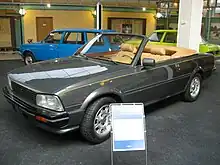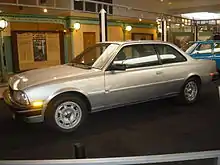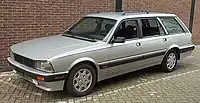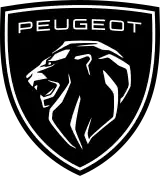| Peugeot 505 | |
|---|---|
_01_rotated.jpg.webp) | |
| Overview | |
| Manufacturer | Peugeot |
| Also called | Guangzhou-Peugeot GP 7202 |
| Production | 1978–1992 (Europe) 1981–1987 (Indonesia) 1981–1991 (Taiwan) 1981–1995 (Argentina) 1990–1997 (China) |
| Assembly | Sochaux, France Guangzhou, China Vigo, Spain Los Andes, Chile Villa Bosch, Argentina Cairo, Egypt (AAV)[1] Heidelberg, Victoria, Australia (Renault Australia) Enfield, Australia (Leyland)[2] Jakarta, Indonesia (Gaya Motor) Bangkok, Thailand (Yontrakit Group) Changhua, Taiwan Setúbal, Portugal (Movauto) Kaduna, Nigeria (PAN)[3] Johor Bahru, Malaysia (OASB)[4] Morocco (Sopriam)[5] |
| Designer | Pininfarina and Peugeot |
| Body and chassis | |
| Class | Large family car (D) |
| Body style | 4-door saloon 5-door estate |
| Layout | FR layout |
| Powertrain | |
| Engine | Petrol engines: 1796 cc XM7A I4 1971 cc XN1/XN6 I4 1995 cc ZEJ "Douvrin" I4 2155 cc N9T "Simca 180" turbo I4 2165 cc ZDJ "Douvrin" I4 2849 cc ZN3J "PRV" V6 Diesel engines: 2304 cc XD2 I4 (NA/turbo) 2498 cc XD3 I4 (NA/turbo) |
| Transmission | 3-speed automatic ZF 3HP22 4-speed automatic ZF 4HP22 4-speed manual BA 7/4 5-speed manual BA 7/5 5-speed manual BA 10/5 |
| Dimensions | |
| Wheelbase | 2,743 mm (108.0 in) (sedan) 2,900 mm (114.2 in) (wagon) |
| Length | 4,579 mm (180.3 in) (sedan) 4,898 mm (192.8 in) (wagon) |
| Width | 1,737 mm (68.4 in) (sedan) 1,730 mm (68.1 in) (wagon) |
| Height | 1,424–1,446 mm (56.1–56.9 in) (sedan) 1,540 mm (60.6 in) (wagon) |
| Curb weight | 1,210–1,410 kg (2,668–3,109 lb) |
| Chronology | |
| Predecessor | Peugeot 504 |
| Successor | Peugeot 405 |
The Peugeot 505 is a large family car produced by the French manufacturer Peugeot from 1978 to 1992 in Sochaux, France. It was also manufactured in various other countries including Argentina (by Sevel from 1981 to 1995), China, Thailand, Indonesia and Nigeria. The 505 was Peugeot's last rear-wheel drive car.[6]
According to the manufacturer, 1,351,254 505s were produced between 1978 and 1992 with 1,116,868 of these being saloons/sedans.[7]
History
Officially unveiled on 16 May 1979,[8] the 505 was the replacement for the 504 with which it shared many of its underpinnings.[9] It was originally available as a sedan/saloon; a station wagon/estate, including an eight-passenger Familiale version, were introduced at the 1982 Geneva Motor Show.[10] The styling, a collaboration between Pininfarina and Peugeot's internal styling department, is very similar to that of the smaller 305.[9] The original interior was designed by Paul Bracq, generally more well known for his work for Mercedes-Benz and BMW.[11] It is known as the "Work Horse" of Africa today. The front-engine, rear-wheel-drive layout differentiated the 505 from many of its marketplace competitors.[12]
After initially being produced only in left-hand drive form for its first few months, the 505 was available in right-hand drive form for the UK market from October 1979. Its best selling competitor in the UK was the Ford Granada.

The 505 was praised by contemporary journalists for its ride and handling, especially on rough and unmade roads; perhaps one reason for its popularity in less developed countries. The 505 also had good ground clearance; if it wasn't enough though, Dangel offered a taller four-wheel drive version of the 505 Break/Familiale equipped with either the intercooled turbodiesel 110 hp (81 kW) engine or the 130 hp 2.2 L petrol (96 kW) engine. The four-wheel drive 505s converted by Dangel also have shorter gear ratios.[13] Initially higher-end petrol models used a fuel-injected alloy engine while lower-end models models used a carburettor, with a diesel also sold.[12]


The estate model was launched in 1982, and was available with seven seats, just like the Peugeot 504 estate. Also new in 1982 was the fully equipped 505 STI, equipped with the all-new 2165 cc four-cylinder Douvrin engine developed together with Renault.[14]
The range was given a facelift, including an all new interior, in 1986, but European Peugeot 505 production began to wind down following the launch of the smaller Peugeot 405 in 1987. Saloon production came to a halt in 1989, when Peugeot launched its new flagship 605 saloon, while the estate remained in production until 1992 - although plans for an estate version of the 605 never materialised. The 605 was in production for a decade but never matched the popularity of the 505. In some countries such as France and Germany, the 505 estate was used as an ambulance, a funeral car, police car, military vehicle and as a road maintenance vehicle. There were prototypes of 505 coupés and 505 trucks, and in France many people have modified 505s into pickup trucks themselves.
The 505 was one of the last Peugeot models to be sold in the United States, with sedan sales ending there in 1990 and wagon sales in 1991. The last sedans sold had PRV's 2.8 V6 engine only. Unique to the US were turbocharged station wagons, both with petrol and diesel engines. 505s were also assembled and sold in Australia. First introduced in October 1980, they were initially assembled by Renault Australia.[15] In March 1981 Leyland Australia took over and kept assembling the 505 until the end of 1983.[2] During 1983, Leyland Australia became Jaguar Rover Australia (JRA) and the new company kept selling Peugeots. From 1984 on, 505s sold in Australia were imported fully built up from France. The 505 was also built in Argentina, Chile, China, and New Zealand. In New York City, Peugeot 505 diesels were briefly used as taxicabs.


In Thailand, the Peugeot 505 sold well. It was available as a CKD version assembled in Bangkok, due to the restrictions on importing completely built-up cars.
Mechanical characteristics
The 505 had rear-wheel drive and the engine at the front, mounted longitudinally. The suspension system included MacPherson struts and coil springs at front and semi-trailing arms with coil springs at rear, with a body-mounted rear differential and four constant-velocity joints. Station wagons (and most sedans built in Argentina) had instead a live-axle rear suspension, with Panhard rod and coil springs. Stabilizer bars were universal at front but model-dependent at rear. The car used disc brakes at the front, and either disc or drum brakes at the rear, depending on the model. The steering was a rack and pinion system, which was power assisted on most models.
Break/Familiale

_02.jpg.webp)
Introduced in the spring of 1982, the Break (Estate) and Familiale versions were quite different from saloons. The wheelbase was also longer, to help make it one of the most spacious in the market, at 2,900 mm (114.2 in). This was, not coincidentally, the same exact wheelbase as had been used on both the 404 and 504 estate derivatives.[10]
The Familiale (family estate), with its third row of bench seats (giving a total of eight forward-facing seats), was popular with larger families and as a taxi. The two rows of rear seats could be folded to give a completely flat load area, with 1.94 cubic metres of load capacity. The total load carrying capacity is 590 kg (1,301 lb). When released, it was hailed as a luxury touring wagon. The Familiale was marketed as the "SW8" in the United States, for "station wagon, eight seats."
In France, Dangel produced a modified version of the Peugeot 505 Break with high suspension and 4WD, which made it look like an early crossover SUV.
Engines
A range of diesel and petrol engines were offered.[16] The first diesels (XD2) arrived in July 1979, two months after the petrol versions.[9] The turbocharged petrol unit was first seen in 1984 (for the 1985 model year in the United States).[17]
505s were mainly equipped with inline-four-cylinder engines, although there was a short run of petrol V6's built after 604 production had come to an end.
| Petrol | |||||||
|---|---|---|---|---|---|---|---|
| Engine layout | Model | Fuel system | Power (DIN) | Torque | Compression ratio | Top Speed km/h (mph) |
Notes |
| 1796 cc OHV I4 | XM7 | Manual choke, single-barrel carburetor | 80 CV (59 kW; 79 hp) at 5500 rpm | 14.5 kg⋅m (142 N⋅m; 105 lb⋅ft) at 2500 rpm | 8.8:1 | 156 km/h (97 mph) | |
| XM7A | Manual choke, twin-barrel carburetor | 90 CV (66 kW; 89 hp) at 5000 rpm | 15 kg⋅m (147 N⋅m; 108 lb⋅ft) at 2750 rpm | 165 km/h (103 mph) | |||
| 1971 cc OHV I4 | XN1 | Manual choke, single-barrel carburetor | 82 CV (60 kW; 81 hp) at 5000 rpm | 16 kg⋅m (158 N⋅m; 117 lb⋅ft) at 2500 rpm | 152 km/h (94 mph) | 1982–1987 Break GL only | |
| XN1A | Automatic choke, twin-barrel carburetor | 96 CV (71 kW; 95 hp) at 5200 rpm later 100 CV (74 kW; 99 hp) at 5000 rpm | 16.4 kg⋅m (161 N⋅m; 119 lb⋅ft) at 3000 rpm | 166 km/h (103 mph) | More powerful version introduced in 1984 | ||
| XN1A | 108 CV (79 kW; 107 hp) at 5250 rpm | 17.2 kg⋅m (169 N⋅m; 124 lb⋅ft) at 3000 rpm | 175 km/h (109 mph) | ||||
| XN6 | Bosch K-Jetronic fuel injection | 113 CV (83 kW; 111 hp) at 5000 rpm | 17.5 kg⋅m (172 N⋅m; 127 lb⋅ft) at 2750 rpm | 176 km/h (109 mph) | SR Injection, only produced in Argentina for the local market[18] | ||
| XN6 | Bosch K-Jetronic fuel injection with catalytic converter | 98 CV (72 kW; 97 hp) at 5000 rpm | 116 lb⋅ft (157 N⋅m; 16 kg⋅m) at 3500 rpm | 8.35:1 | Reserved for the North American market and other countries that required catalytic converter. | ||
| 1995 cc OHC I4 | ZEJK 829B | Bosch K-Jetronic fuel injection | 110 CV (81 kW; 108 hp) at 5250 rpm | 17.4 kg⋅m (171 N⋅m; 126 lb⋅ft) at 4000 rpm | 9.2:1 | "Douvrin Engine" | |
| 2165 cc OHC I4 | ZDJK | Bosch K-Jetronic fuel injection | 117 CV (86 kW; 115 hp) at 5750 rpm | 19.0 kg⋅m (186 N⋅m; 137 lb⋅ft) at 3500 rpm | 9.2:1 | 178 km/h (111 mph) | This was a longer stroke version of the ZEJK |
| ZDJL 851B | Bosch LE2-Jetronic fuel injection | 130 CV (96 kW; 128 hp) at 5500 rpm | 19.2 kg⋅m (188 N⋅m; 139 lb⋅ft) at 4250 rpm | 9.8:1 | 185 km/h (115 mph) | Acceleration from 0 to 100 km/h: 10.0 s | |
| ZDJL 851Y | Bosch LE2-Jetronic fuel injection | 130 CV (96 kW; 128 hp) at 5750 rpm | 19.2 kg⋅m (188 N⋅m; 139 lb⋅ft) at 4250 rpm | 9.8:1 | Practically the same as ZDJL 851B, but with little changes to meet other countries legislation requirements. | ||
| ZDJL 851X | Bosch LU2-Jetronic fuel injection with catalytic converter | 122 CV (90 kW; 120 hp) at 5000 rpm or 115 CV (85 kW; 113 hp) at 5000 rpm | 18.1 kg⋅m (178 N⋅m; 131 lb⋅ft) at 3500 rpm or 17.5 kg⋅m (172 N⋅m; 127 lb⋅ft) at 3500 rpm | 8.8:1 | 178 km/h (111 mph) | ||
| 2155 cc OHC I4 | N9T | Garrett Turbocharger, Bosch L-Jetronic | 150 CV (110 kW; 148 hp) at 5200 rpm | 24 kg⋅m (235 N⋅m; 174 lb⋅ft) at 3000 rpm | 7.5:1 | 200 km/h (124 mph) | Also known as the "Simca Type 180" engine. Acceleration from 0 to 100 km/h: 8.8 seconds. |
| N9TE | Intercooler, Garrett turbocharger, Bosch L-Jetronic | 160 CV (118 kW; 158 hp) at 5200 rpm | 25 kg⋅m (245 N⋅m; 181 lb⋅ft) at 3000 rpm | 8:1 | 205 km/h (127 mph)[19] | ||
| N9TEA | Intercooler, turbocharger, Bosch L-Jetronic | 180 CV (132 kW; 178 hp) at 5200 rpm | 28 kg⋅m (275 N⋅m; 203 lb⋅ft) at 3000 rpm | 8:1 | 210 km/h (130 mph) | Equipped with an electronic boost controller; acceleration from 0 to 100 km/h: 8.4 seconds. | |
| 2849 cc OHC V6 | ZN3J 154F | Bosch LH-Jetronic fuel injection | 170 CV (125 kW; 168 hp) at 5600 rpm | 24 kg⋅m (235 N⋅m; 174 lb⋅ft) at 4250 rpm | 10:1 | 205 km/h (127 mph)[20] | Acceleration from 0 to 100 km/h: 9.2 s |
| ZN3J 154X | Bosch LH-Jetronic fuel injection with catalytic converter | 147 CV (108 kW; 145 hp) at 5000 rpm | 23.9 kg⋅m (234 N⋅m; 173 lb⋅ft) at 3750 rpm | 9.5:1 |
| Diesel | |||||||
|---|---|---|---|---|---|---|---|
| Engine layout | Model | Fuel system | Power | Torque | Compression ratio | Top Speed km/h (mph) |
Notes |
| 2304 cc OHV I4 | XD2 | pre-chamber IDI | 70 CV (51 kW; 69 hp) at 4500 rpm | 13.4 kg⋅m (131 N⋅m; 97 lb⋅ft) at 2000 rpm | 22.2:1 | 141 km/h (88 mph) | From the Peugeot 504, was used on early models, and was also supplied by Peugeot to Ford for the Sierra and Granada |
| XD2C | 70 CV (51 kW; 69 hp) | ||||||
| XD2S | Garret turbocharger, IDI | 80 CV (59 kW; 79 hp) at 4150 rpm | 18.8 kg⋅m (184 N⋅m; 136 lb⋅ft) at 2000 rpm | 21:1 | 160 km/h (99 mph) | ||
| 2498 cc OHV I4 | XD3 | pre-chamber IDI | 76 CV (56 kW; 75 hp) at 4500 rpm | 15.3 kg⋅m (150 N⋅m; 111 lb⋅ft) at 2000 rpm | 23:1 | 150 km/h (93 mph) | |
| XD3T | Garret turbocharger, IDI | 95 CV (70 kW; 94 hp) at 4150 rpm | 21 kg⋅m (206 N⋅m; 152 lb⋅ft) at 2000 rpm | 21:1 | 170 km/h (106 mph) | Used on 1985 and newer models | |
| XD3TE | Intercooler, turbocharger IDI | 110 CV (81 kW; 108 hp) | 24 kg⋅m (235 N⋅m; 174 lb⋅ft) at 2000 rpm | 178 km/h (111 mph) | GTDT |
Trim levels
.jpg.webp)
Peugeot 505 models varied very much in equipment. Base SRD cars with the 2,304 cc diesel engine didn't even have power steering, but the GTD Turbo, the GTI, the V6, and the TI all had power steering, central locking doors, air conditioning, a five-speed manual transmission, sunroof (except the GTD Turbo), and front fog lights. In the V6, the power steering was speed-sensitive, the central locking doors came with an infrared remote, and the heating and ventilation systems included electronic climate control. A three-speed automatic transmission was available on early 505s, which was later replaced by a four-speed unit. The most durable 505 model proved to be the GTD with a five-speed manual transmission. In Australia, the 505 was sold as a GR, SR, STi, or GTi sedan, or an SR or GTi eight-seater station wagon, all with petrol engines. Very few GRD and SRD diesel-engined 505s were sold in Australia. The Series II update saw the SR replaced with an SLi.
North America
The United States and Canada had their own 505 body, which arrived for 1980 and was first introduced on the French Caribbean island of Martinique.[11] Notable differences were: gas tank moved inwards (now behind rear bench), with filling neck on rightside, different style quad headlamps, taillights (pre-1986 sedans), distinctive whip antenna moved from roof to rear fender (and changed to telescopic), larger bumpers, tailpipe moved from right to left. Fewer engines were offered, all detuned to meet more restrictive emission standards. The models sold in North America were: Base, "GL", "S", "GLS", "STI", "DL", "Liberté", "STX", "Turbo", "GLX", "SW8", "V6", "Turbo S". Originally, only the 96 hp (72 kW) 2.0-liter four was offered, alongside the 2.3-liter diesel with 71 hp (53 kW). Both were carryovers from the 504, although the gasoline unit had gained eight horsepower thanks to the introduction of fuel injection.[21]
Diesel sales were strong in the aftermath of the energy crisis, with diesels reaching a peak level representing 85 percent (14,430 diesels) of the company's US sales in 1981 (their best year in the US). Both the XD2S and larger XD3T were available in the US for model years 1985 and 1986, with the smaller engine being fitted to station wagons. By 1986, after the Oldsmobile diesel debacle and many years of stable fuel prices, only the turbodiesel remained and diesel sales were down to a share of just over 10 percent (1,545 out of 14,439).[22] New for 1987 was the limited edition Liberté model (so named in honor of the centennial celebration of the Statue of Liberty).[22] The well equipped Liberté was priced considerably higher than the 2.2-litre GL, close to the GLS model, but received the much less powerful 2-liter petrol "four" producing 97 hp (72 kW) in the sedan and 95 hp (71 kW) in the wagon.[23] Diesel engines were no longer available in the US after 1987.[24]
All North-American bound 505's were built in Peugeot's Sochaux Plant, in France. In December 1980, as a late introduction for the 1981 model year, a 2.3-liter turbodiesel model with 80 hp (60 kW) arrived.[25] Unlike the naturally aspirated model, the turbodiesel received a five-speed manual as standard fitment.[26] The turbodiesel was very successful as it had no direct competitors in the United States market and represented nearly half of all Peugeot sales during the first model year.ref name=wardsEU8/> In the late spring of 1984, the 1985 505 Turbo arrived. The engine was similar to the one seen in Europe, albeit initially without an intercooler. Max power for 1985 was 142 hp (106 kW).[17] This eventually climbed to 180 hp (134 kW) for later model years. The Turbo estate version was unique to the North American markets.
.jpg.webp) Early model Peugeot 505 Diesel with round headlamps (USA)
Early model Peugeot 505 Diesel with round headlamps (USA).jpg.webp) 1987 Peugeot 505 Turbo S, showing North America-specific taillights and exhaust on the left (USA)
1987 Peugeot 505 Turbo S, showing North America-specific taillights and exhaust on the left (USA) 1991 Peugeot 505 Turbo SW8 - the eight-seater version of the Turbo wagon, never sold outside of North America
1991 Peugeot 505 Turbo SW8 - the eight-seater version of the Turbo wagon, never sold outside of North America.jpg.webp) 1992 Peugeot 505 DL Station Wagon - late US-market models received large, deep-skirted bumpers
1992 Peugeot 505 DL Station Wagon - late US-market models received large, deep-skirted bumpers
Notes and references
- Flammang, James M. (1994). Standard Catalog of Imported Cars, 1946-1990. Iola, WI: Krause Publications, Inc. ISBN 0-87341-158-7.
- ↑ "Arab American Vehicles Co". Aav.com.eg. Retrieved 2010-06-19.
- 1 2 Sykes, Barry (2003-01-25). "Leyland". National Magazine. Retrieved 2013-01-28.
- ↑ "About Us - PAN Nigeria Limited". PeugeotNigeria.com. Retrieved 1 May 2017.
- ↑ Leeps (1989-06-04). "Rust Busters". New Straits Times. Retrieved 2015-05-24.
- ↑ "Dossier le secteur automobile marocain" (pdf). Al Wassit Magazine (in French). May–June 1998.
- ↑ Allain, François (1996). Guide Peugeot: Tous le modèles de 1970 à 1990 (in French). E/P/A. p. 60. ISBN 2-85120-493-9.
- ↑ Musée de l'Aventure Peugeot. The exhibit label (2012) states: «Le 505 fut produit de 1978 a 1999 en 1,351,254 exemplaires, dont 1,116,868 berlines.»
- ↑ Bellu, René (2006). "Automobilia". Toutes les Voitures Françaises 1979 (Salon [Paris, Oct] 1978). Paris: Histoire & collections (84): 41.
- 1 2 3 Costa, André & Georges-Michel Fraichard, ed. (September 1979). "Salon 1979: Toutes les Voitures du Monde". l'Auto Journal (in French). No. 14 & 15. Paris: Homme N°1. p. 106.
- 1 2 Wyler, Martin (March 3, 1982). Büschi, Hans-Ulrich (ed.). "Am Wendepunkt/Tournant" [Turning point]. Automobil Revue '82 (in German and French). Berne, Switzerland: Hallwag, AG. 77: 57. ISBN 3-444-06062-9.
- 1 2 Hogg, Tony (ed.). "Peugeot 505: "Progress not compromise, the Peugeot for the Eighties" — P.S.A. Peugeot-Citroën". Road & Track's Road Test Annual & Buyer's Guide 1981. No. January-February 1981. p. 142.
- 1 2 Walton, Jeremy (July 1979). "The Peugeot 505". Motor Sport magazine. Retrieved 22 October 2023.
- ↑ Pappas, Thanos (2022-01-04). "At €59,000, Can This 1985 Peugeot 505 Break 4×4 Dangel Lift Your Spirits Up?". Carscoops. Archived from the original on 2022-01-04.
- ↑ Hogsten, Dag E. (1982-11-03). "Prylglädje och extra kraft" [Gadgets and extra power]. Teknikens Värld (in Swedish). Vol. 34, no. 22. Stockholm, Sweden: Specialtidningsförlaget AB. p. 54.
- ↑ Dickie, Neil (September 2009). "Thirty Years of the 505". Torque. Vol. 50, no. 8 ("909"). The Peugeot Car Club of Victoria. p. 14. Archived from the original on 2023-06-03.
- ↑ Wright, Tom. "Peugeot engine codes". Clubpeugeotuk.org. Retrieved 2010-12-04.
- 1 2 Stanley, Dean (1984-04-08). "What's New: 505 Turbo". Autoweek. Vol. 35, no. 14. Crain Press Inc. p. 14. ISSN 0192-9674.
- ↑ Figueras, Carlos (July 1986). "El adelantado de una nueva era". Parabrisas (in Spanish). No. 98. Archived from the original on 2012-12-24.
- ↑ "Turbo Injection N9TE Technical Description, PDF p. 8" (PDF). 505Turbo.com.
- ↑ "Peugeot 505 V6 brochure, 1987".
- ↑ Progress not compromise..., pp. 143-144
- 1 2 Stark, Harry A., ed. (1987). Ward's Automotive Yearbook 1987. Vol. 49. Detroit, MI: Ward's Communications, Inc. p. 177. ISBN 0910589007.
{{cite book}}: CS1 maint: ignored ISBN errors (link) - ↑ Ward's Automotive Yearbook 1987, p. 183
- ↑ Flammang, pp. 498–499
- ↑ "Input". Ward's Engine Update. Ward's Communications, Inc. 7 (8): 1. 1981-04-15.
- ↑ Hogg, Tony (ed.). "1981 Buyer's Guide". Road & Track's Road Test Annual & Buyer's Guide 1981. No. January-February 1981. p. 110.
External links
 Media related to Peugeot 505 at Wikimedia Commons
Media related to Peugeot 505 at Wikimedia Commons
